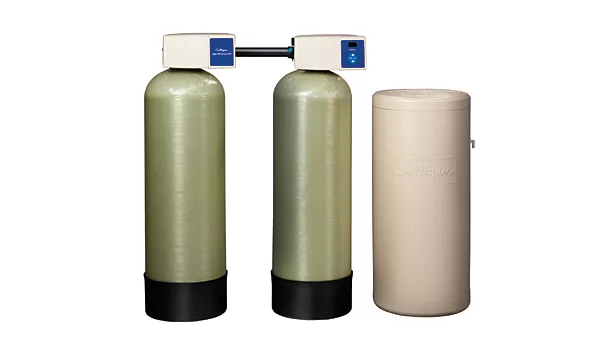Reducing boiler alkalinity will lower steam and condensate-line corrosion
Treat it right.

A 1.5-in. twin commercial water softener is pictured. The dealkalizer system should be preceded by a water-softening system because the hardness in the supply water tends to foul the anion resin. Photos courtesy of Culligan International

A 24-in. to 42-in. dealkalizer is pictured. The recommended concentration of total alkalinity in boilers with operating pressure of 100 psig is 900 ppm and goes down to 500 ppm at an operating pressure of 600 psig. Photos courtesy of Culligan International

A 48-in. to 60-in. dealkalizer is pictured. Dealkalization with a strong base anion ion exchance resin removes about 90% of the alkalinity. Photos courtesy of Culligan International
Alkalinity in steam-generating boilers is a problem because under heat the alkalinity breaks down to carbon dioxide, which passes with the steam. When the steam becomes condensate, the carbon dioxide becomes carbonic acid, which is corrosive to the steam lines.
Water contains alkalinity. The amount depends on the source of the water, be it surface water (lakes and rivers) or groundwater (well water). The amount of alkalinity normally is expressed as Total M-alkalinity (there also is P-alkalinity, which measures the amount of carbonate and hydroxyl alkalinity present in terms of “ppm as calcium carbonate”). This measurement can vary depending on the location of the surface water, depth of the well and type of soil the well is in.
The alkalinity is principally carbonate (CO3) or bicarbonate (HCO3) anions, which can be expressed in parts per million or as grains per gallon. One gpg equals 17.1 ppm. As the operating pressure in the boiler goes up, both the total dissolved solids and alkalinity should go down. The recommended concentration of total alkalinity in boilers with operating pressure of 100 psig is 900 ppm and goes down to 500 ppm at an operating pressure of 600 psig.
The recommended water tests are pH, M-alkalinity, total dissolved solids, iron and hardness. The alkalinity can be removed and/or decreased in several ways:
- Acid feed (if the company is prepared to handle acid);
- Degasifier;
- Lime-soda softening;
- Hydrogen cycle ion exchange/soft water split-stream makeup; and
- Dealkalization with strong base anion ion exchange resin.
Depending on the operating pressure, you may want to consider reverse osmosis or deionization to lower both the alkalinity and the total dis-solved solids because strong base anion resin does not reduce TDS. Depending on the size of the boiler and operating pressure, many of these systems may not be cost-effective.
Dealkalization with a strong base anion ion exchange resin removes about 90% of the alkalinity. One advantage of the ion exchange dealkalizer is that it does not require a mechanical repressurization system (such as a pump), which the other methods require except for the hydrogen cycle split-stream. You can go directly to a makeup or condensate tank.
Dealkalization (salt-splitting process) is an ion exchange system for the reduction of bicarbonate alkalinity of the raw (makeup) water, generally to a steaming boiler. The equipment is very similar to a water softener. As a matter of fact, the dealkalizer system should be preceded by a water-softening system because the hardness in the supply water tends to foul the anion resin.
The anion resin is a strong base resin that reduces and replaces the bicarbonate alkalinity, sulfate and nitrate anions with chloride without the use of acid. The anion resin is regenerated with a normal salt brine solution as the brine passes through the anion resin during the regeneration. The chloride anion of the salt displaces carbonate, bicarbonate, sulfate and nitrate ions on the anion resin exchange sites and replaces them with chloride.
Those displaced anions and excess salt are rinsed to the drain during slow and fast rinse. When the application requires removal of carbon dioxide in the water, it may be necessary to add a small chemical-metering pump to add caustic sodium hydroxide to the brine tank before regeneration. This allows the anion resin to convert carbon dioxide to the bicarbonate ion, which would then be removed by the anion resin.
Both the water softener system and the dealkalizer system should be a meter-regenerated duplex alternating system, which would have one water softener and one dealkalizer in service and one of each on standby. This would provide a continuous supply of softened and dealkalized water to meet the requirements of a continuous operation. This system would keep up with the demand and regenerate when necessary.
When designing the system, it is necessary to have a complete water analysis, know the cycles of concentration, operating pressure and blow-down of the boiler plus the makeup flow rate and the daily capacity of treated water required in gallons per day.
Find a knowledgeable company or individual who either can install the equipment or at least supervise the installation and startup, including training operating personnel and the establishment of operating limits. It will still be necessary to continue internal chemical treatment of the boiler, which may reduce some of the chemical treatment.
An additional problem with both high alkalinity and high TDS is carryover of solids to the steam lines and foaming, which results in fouled steam lines and traps plus deposits on turbines.
Reducing the alkalinity in the boiler will reduce the corrosion of the steam and condensate lines.
Joel Pedigo has 45 years experience in commercial/industrial water treatment. Pedigo also is an Illinois Department of Health-certified NTNCPWS opera-tor.
Looking for a reprint of this article?
From high-res PDFs to custom plaques, order your copy today!







